SEPTEMBER SONG
There’s a great deal to like about September, and the month sings a sort of internal song of celebration that never grows old. When I was a boy growing up in the Smokies, the arrival of September, especially once you got past Labor day weekend, meant that months lay ahead without the mixed blessing of folks variously known to locals as outlanders, flatlanders, and Floridiots. I say mixed blessing because tourism was a driving factor in the local economy, and not everyone welcome the disappearance of dollars outsiders brought to the local economy. The general sentiment, however, and you have to remember that mountain folks are notoriously xenophobic, was an unuttered but heartfelt attitude of “good riddance.” More than once I heard local residents, especially older ones, mutter something to the effect of “we like their dollars but there ain’t much else about them to warm the cockles of a body’s heart.” Obviously that sort of outlook wasn’t unique to the high country, because those familiar with Robert Ruark’s tales of “The Old Man and the Boy” will recall the Old Man (Ruark’s grandfather) referring to bumptious, unmannerly, and overbearing outsiders as “Willies off the pickle boat” and eventually, under considerable duress, giving one such overbearing fellow a solid punch in the nose.
Yet there’s far more to like about September than the changing of seasons and freedom from tourists (that’s no longer the case, incidentally, because in today’s world “leaf peepers” flock to the high country like yellow jackets to a soda pop as nature begins to put on her colorful autumn garments). Here are some of the sights, smells, and sensations which are a part of September’s sweet song and cause to celebrate the month.
*It’s not August, and except for February that’s a plus for any month.
*September means October is just around the corner.
*It’s a discernible change in the air, one better experienced in person than described in print, where you can literally smell coming fall.
*It’s a “see forever” day after the passage of a cold front when the skies are blue as a robin’s egg and so much as a hint of a cloud would seem totally out of place.
*It’s pawpaws ripening and filling a woodland bottom with a wonderful aroma.
*September is a popcorn popper of a dove shoot, with grey-winged speedsters filling the sky and joyful cries of “mark right” or “coming behind you” ringing across sere fields of summer’s end.
*It’s a month when old bucks first begin to feel stirrings of procreation and start wandering as they rub their adornments and make scrapes.
*With any luck and the passage of a powerful cold front, it’s a time when there is a most welcome bit of chill in the air as night gives way to light and again at dusk when twilight edges towards night.
*It’s katydids singing like there’s no tomorrow, and for them there are indeed relatively few tomorrows left.
*September is a lad grown old thinking back to how he once could scarcely contain himself as he awaited the opening day of squirrel season.
* The Harvest Moon is just past (this year it fell on September 20) and what for me are the inexpressible joys of October’s Hunter’s Moon lie just under a month away.
*It’s longing looks backward to a time when school didn’t begin until September and when every teenager, although they would have gone through excruciating torture before admitting as much, anxiously awaited the resumption of classes and all that brought—seeing old friends, checking out new classmates, finding out what teachers you were “stuck” with (never pausing for a moment to consider the fact that they might have reciprocal feelings about being “stuck” with you), seeing if the focus of your late spring romance was still interested in you (remember that when I was a youngster teenagers didn’t have vehicles and a girl friend who lived out in the county a dozen miles away might as well have been resident in the suburbs of Timbuktu), and just generally relishing the excitement which accompanied the opening of another year of school.
*The month is harvest time—pumpkins turning fields into a colorful patchwork of orange and gold; ground cherries beckoning those living close to the land as an impromptu treat; withered and fully ripe maypops doing the same; hazelnuts there for the taking if you can beat the bushytails to them; persimmons showing color and alerting those closely attuned to nature’s bounty of treats to come; pears to be picked, canned, dried, or eaten fresh; and so much more to fill a country boy’s tummy.
*Finally, and it’s a matter which is mighty meaningful to me in terms of loving, lingering memories, September is apple time. Each year at this season I look back with wondrous longing to boyhood days when apple time rolled around and all the varied aspects of tending to our small orchard came to fruition.
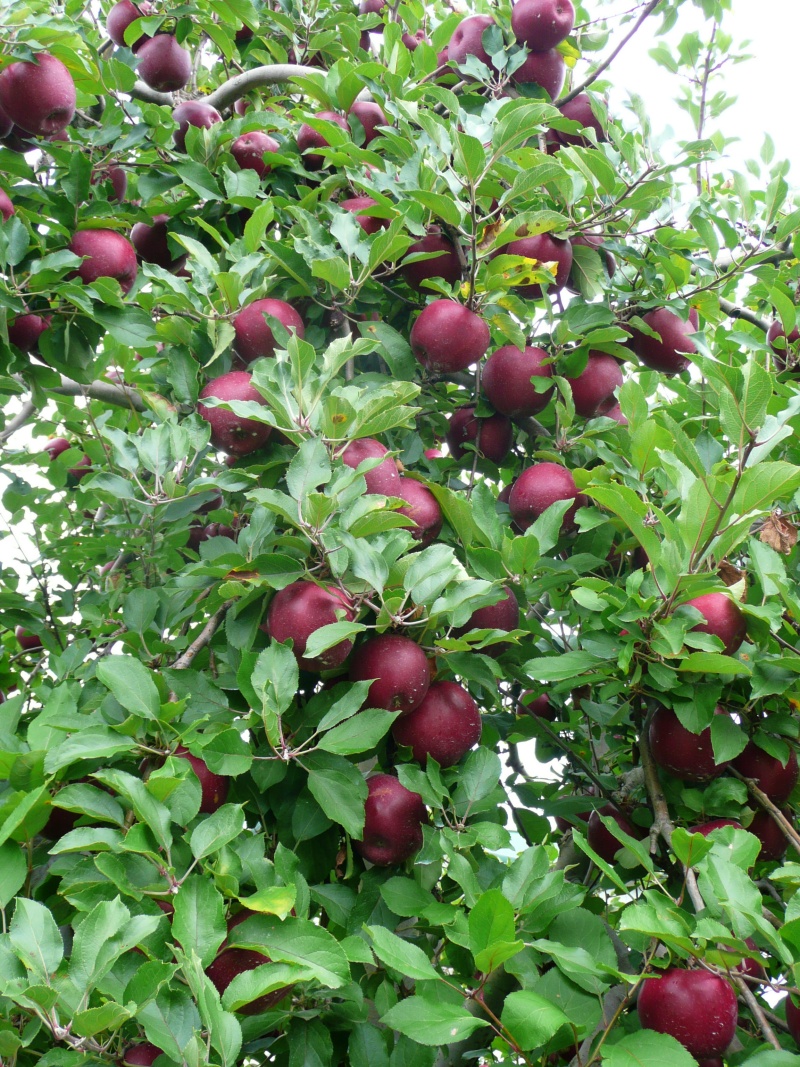
For all my passion for October though, when it comes to a single powerful memory of autumn, the days around September’s Harvest Moon take pride of place. That’s for the simple reason events associated with it during my boyhood laid a strong, enduring hold on my soul. In my youth we had a tiny but meticulously maintained apple orchard, and over the course of the year it was the focus of appreciable hard work—pruning, multiple sprayings to protect both trees and the fruit they bore, and efforts associated with harvesting the fruit. The fact that the trees were planted on a steep hillside and that our spraying device was a one-wheeled tank handled somewhat like a wheelbarrow didn’t make things any simpler. Filled with gallons of spray to the point where it probably weighed 200 pounds or more, moving that device around was as awkward as it was arduous.
Picking time was demanding as well, but for all that was the case, I absolutely loved it. The Harvest Moon signaled that the apples were ready, and although I never specifically noted the coincidence, I feel quite certain that year after year we gathered the fruit sometime within a week of the full moon. Already I would have been plucking a couple of juicy Red Delicious daily on my daily walk to school–one to eat en route and the other to polish until it became a giant, edible ruby to present to my teacher.
There would be regular apple peeling, coring, and quartering on the porch during the slightly chilly but comfortable hour or two after supper. Momma was never satisfied until she had scores of quart jars filled with cooked apples, and at some point during the process the results of one or two evenings of labor would be sliced thin to be dried.
We would enjoy apples in our diet at this time of year and indeed on through the winter. I loved stuffing a couple of Golden Delicious in the pouch of my Duxbak hunting jacket as I headed out after squirrels as soon as I got home from school, and stewed apples were as commonplace on our family table as cornbread.
Most of all though, in the corridors of fond memory I look back in longing to the many culinary offerings, mostly desserts, that featured those lovingly nurtured, delicious apples. After all, I’ve always had a pronounced sweet tooth. Momma and Grandma Minnie utilized them in an impressive variety of ways. Without question my three favorites were fried apple pies (often known as half moons of mule ears because of their shape, a traditional stack cake which was Grandma’s specialty, and what Momma styled an applesauce cake. I’ve focused on apple recipes in this month’s offerings in that regard which appear below.
JIM’S DOIN’S
A couple of days after the appearance of the August newsletter a few weeks back, I received a phone call which has to qualify as the most remote response yet, geographically speaking, to my monthly meanderings. It was from a reader in Ecuador, a fellow I coached in soccer at Winthrop University many decades ago when that sport was an important part of my life. We talked about the upcoming marriage of his son, old times, good times, and sad times since one of his teammates, Glenn Dinga, was on the verge of death (and has since passed away). It was a poignant reminder of life’s uncertainties and of the importance of savoring every moment to the utmost. I hung up the phone (and yes, tech wreck that I am, I actually still use a phone that you hang up) and sat, misty-eyed, as I realized how blessed I had been to coach scores of individuals making the transition from adolescence to adulthood even as I hoped I had some positive influence on them. If nothing else, I look back on what they have become and accomplished (this particular individual, Guido Paez, had just taken over as CEO of a major enterprise in Ecuador) with fondness and considerable pride.
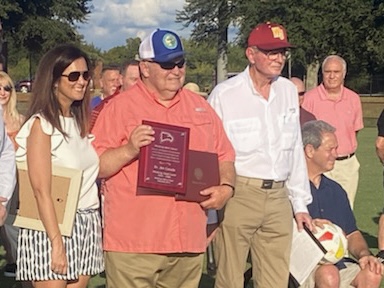
My daughter, Natasha and me with some of the players and their family members in attendance in the background.
Still looking back on my coaching days, which admittedly lie far outside the hunting/fishing/cooking/nature/Southern Appalachians interests which are the main thrust of this newsletter, Saturday, September 18, was a truly magical day for me. It involved a sort of homecoming, something guys I had the privilege of coaching over the course of 12 years have done periodically for the last decade or more, gathering to share fond memories of joyous younger days. In this case, the gathering also involved an official announcement of the endowed soccer scholarship they have created in my name. There was a luncheon to kick things off, and after a somber note with a few moments of silence while the names of deceased players who now play beneath a September sun in the fields of forever were mentioned, one by one, and a thoughtful, telling prayer by a former player who is now an Episcopalian priest, things turned in a lighthearted direction.

Pend Armistead, one of the organizers of the event,
and me sharing a laugh about some memory.
I was remembered (and roasted) by a goodly number of former players, and during that often raucous time of laughter I’d like to think I gave at least as good as I received. I’ve mentioned this before but continue to be flattered, flabbergasted, and deeply moved by the effort underlying creation of the endowed scholarship, and this luncheon, followed later in the afternoon by tailgating at a Winthrop University home soccer match and a halftime ceremony, reinforced all those feelings. Probably 75 or 80 former players, spouses, family members, and avid followers of the team whom I described as “groupies” until one of them laughingly reminded me that word usage often has connotations of a sort I didn’t intend, joined my daughter, Natasha, and me at midfield for a halftime ceremony. There I was presented with a soccer ball signed by all the assembled athletes from yesteryear, a lovely plaque, and other memorabilia.
It was a moment to cherish on a personal level, but what touches me most is not what these guys have done in my honor. Rather, it is the strength of the ties these players have maintained with one another over the course of better than four decades along with seeing what they have achieved as citizens, parents, and general successes in life. Their collective growth from a bunch of happy-go-lucky, live for the day, irrepressible, testosterone overladen, and yes, sometimes irresponsible college students to where they are today still amazes me even as it gives me a great deal of inner satisfaction to have been a tiny part of it.
In the last two weeks I have returned my edits to and comments on the copyedited versions of the two books I have completed in recent months, and from here forward it’s mainly a matter of seeing them through the press process to publication. I’ll keep you updated on everything connected with them, but I can say that the titles of the books have been finalized. The one being published by the University of Georgia Press is Fishing for Chickens: A Smokies Food Memoir, while the one to appear under the Sporting Classics imprint is Lords of the Veldt and Vlei: Pioneering Hunters in Africa.
LAUGHTER IS THE BEST MEDICINE
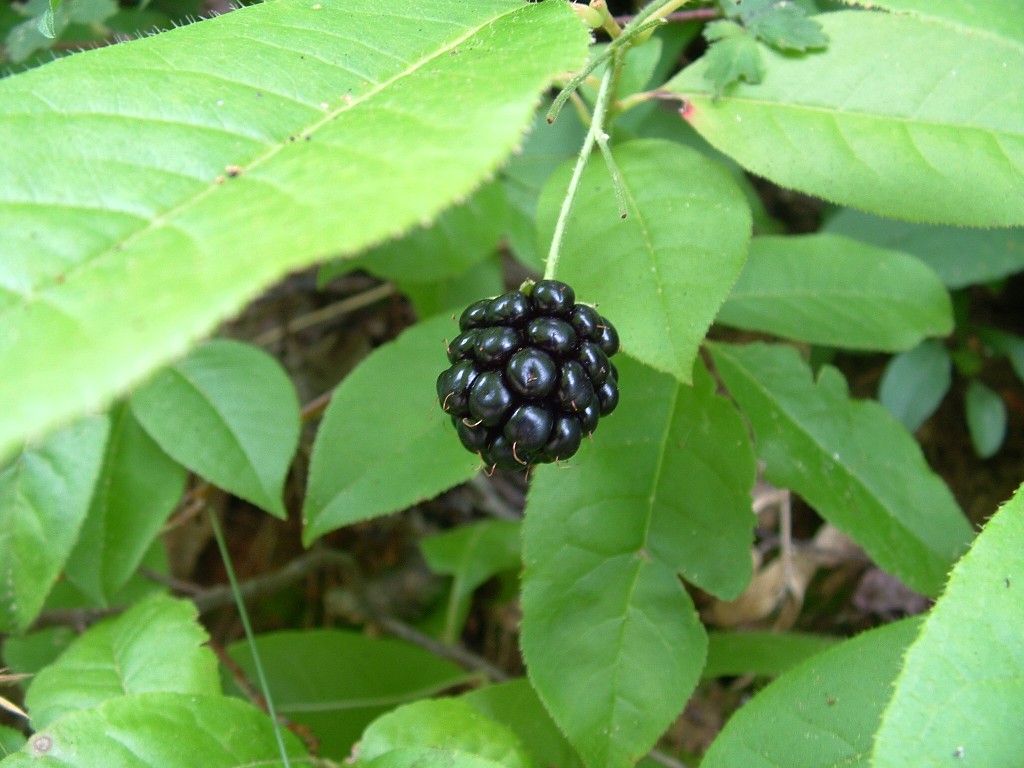
A dewberry.
Dewberries have afforded intriguing moments in my life well beyond the culinary wonders that can be wrought with their berries. I’d love to have a hundred dollar bill for every rabbit I jumped during my boyhood hunting days in a thicket of dewberry briars. Rabbits find a patch of dewberries the perfect place to spend the day, especially in cold but sunny situations during the late fall and winter.
A dewberry patch and a crippled rabbit also provided a moment of visual high comedy that comes back to me clearly despite the passage of more than a half century. My good friend and boyhood hunting buddy Jackie Corbin (he later became an internationally known research scientist involved in the development of Viagra) got a shot at a rabbit being chased by our pack of beagles. He hit the rabbit with his single-shot shotgun but didn’t drop it on the spot. Thinking he could catch the cottontail as it fled through a dewberry patch, he took off after it like a two-legged beagle.
In doing so, he forgot the strength and tenacity of dewberry briars. Grubby (Jackie’s nickname) caught one foot on a briar runner and it didn’t give even a little bit. Suddenly he was airborne, and at that moment he displayed all the agility and “cattiness” that made him such a great high school athlete. Jackie turned a complete flip, using his gun as a bit of a prop while doing so, and hit the ground running almost as if nothing had happened. Of course, when it was all over (he caught the rabbit), it took Daddy and his best hunting buddy, Claude Gossett, a quarter of an hour to get all the red clay mud out of Grubby’s gun barrel.
COOKING CORNER
Momma to some degree and Grandma Minnie in large measure worked from the “I’ve always done it this way” approach when it came to cooking. That is to say, they didn’t use specific measurements and Grandma didn’t even own many devices which provided specific measurements. So the recipes which follow are, to a considerable degree, my best recollection of how they prepared them.
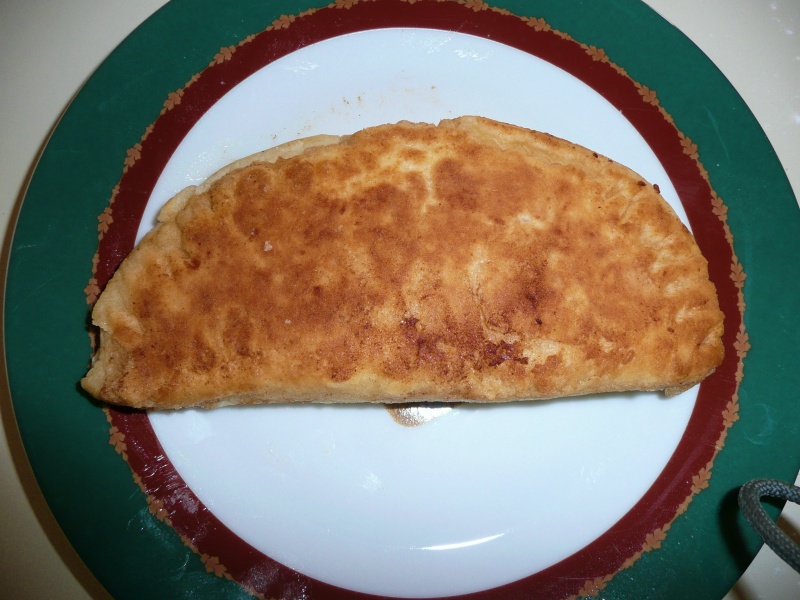
FRIED APPLE PIES
1 pound dried fruit
¾ cup brown sugar
2 teaspoons of cinnamon (or to taste)
2 tablespoons butter
Cover the dried fruit with water and soak overnight. Drain any extra water, add the other ingredients, and cook slowly until completely tender, mashing the fruit as it cooks. Allow to cool while making regular pastry crust, using a bit less shortening than you would ordinarily, roll out thin with and then cut in circles. Grandma always got perfect circles by using a suitably sized saucer to make an imprint then cutting around it. Once the crust is ready, add fruit to half the circle, use a fork to crimp and seal the edges, and pop into a greased frying pan or atop a griddle. Fry, turning only once. Drain on paper towels and serve while still warm. If desired, you can sprinkle each pie with cinnamon or cinnamon sugar.
FRESH APPLE CAKE
3 cups sugar
3 cups self-rising flour
4 eggs
1 cup raisins
1 cup cooking oil
3 cups apples, diced small
1 cup black walnuts
2 teaspoons vanilla
Beat the eggs and add remaining ingredients. Batter will be stiff. Bake for one hour at 350 degrees.
FROSTING
1 13-ounce package of cream cheese (softened)
¼ cup butter or margarine (melted)
2 cups powdered sugar
1 teaspoon vanilla
Whisk ingredients together and once thoroughly mixed use a spatula, broad-bladed knife, or similar device to cover the cake.
APPLESAUCE CAKE
This is a recipe I’ve shared before, usually around Christmas because that’s the time we always enjoyed this delicacy, but the background of Momma’s wonderful applesauce cakes went back to pickin’ time in September. Momma always made her applesauce cakes for Christmas during the Thanksgiving holiday. The ensuing month or so would see them stored in a cold area (usually the unheated downstairs bedroom) and periodically anointed with a few tablespoons of apple cider to keep them moist. This combination of aging and moisturizing produced a cake which was, by the time Christmas rolled around and it was sliced, soaked through and through with toothsome goodness. A slice literally glistened with moisture and tasted heavenly.
1 cup butter
2 cups sugar
4 cups flour
1/3 cup cocoa
4 teaspoons baking soda
1 teaspoons cinnamon
2 teaspoons allspice
2 cups raisins
3 cups applesauce
2 cups black walnut meats
2 teaspoons vanilla
Pinch of salt
Cream butter and sugar. Add applesauce and remaining ingredients a small amount at a time, stirring by hand as you do so. Bake for 50 minutes to an hour at 350 degrees. Check with toothpick to see if cake is done.
OLD-FASHIONED APPLESAUCE
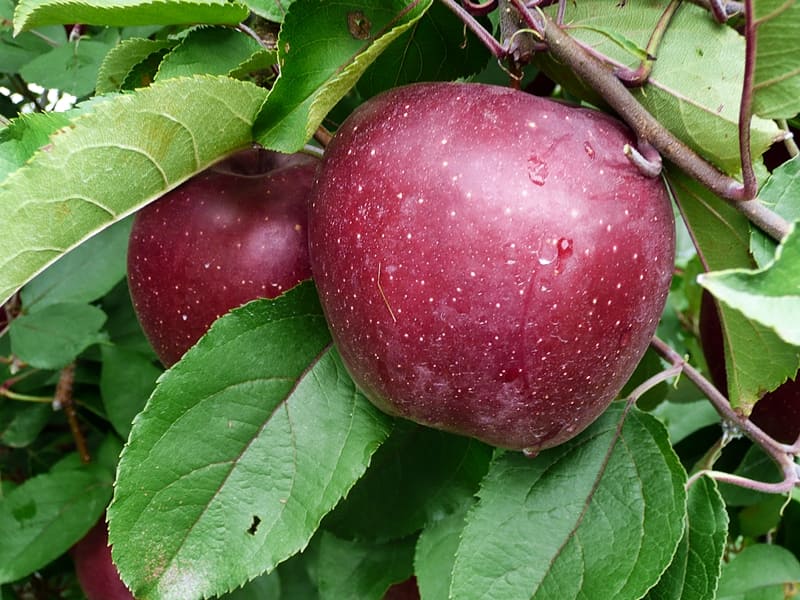
To me real applesauce (often simply styled fruit by mountain folks,) is a far superior dish to the insipid stuff which comes in a can or jar from your local grocery store. Momma had a goal of canning 200 quarts annually, and that translated to applesauce being on our family table with great regularity. The way she made and canned applesauce was the essence of simplicity. She peeled, cored, and quartered apples, often doing several bushels at a time. If she was dealing with a particularly large batch, such as the main picking from our Golden Delicious trees, it was all hands on deck for the peeling and quartering. The prepared apples would be put in a dish pan filled with salted cold water until all was in readiness.
Cooking, usually in the largest soup or stew pots available, involved nothing more than putting the apples in the container, adding a bit of water, bringing to a simmer while stirring occasionally, and cooking until the quarters had softened or dissolved. A big wooden spoon was used for stirring, and when there were no longer discernible quarters of the apples to be seen, the sauce was ready for processing in quart jars. Sometimes the applesauce would be a bit tart, but no sweetening was added in the cooking and canning process. That waited until a jar was opened and a taste test indicated whether any sugar was needed. Occasionally a hint of cinnamon or honey (instead of sugar) would be introduced at that point. We often enjoyed applesauce straight from the jar but sometimes heated in cold weather. With a couple of pats of butter melted into the fruit, it was a treat with any meal, and I liked a dollop of cream added as well.
Canning large batches of apple sauce is still possible, and sometimes orchards or large roadside stands will offer you can a special deal on culled, bruised, or otherwise less than ideal fruit which is perfectly suitable for canning. Alternatively, you can fix a small batch of fruit and store it in the refrigerator. It will keep perfectly well for a week or so.